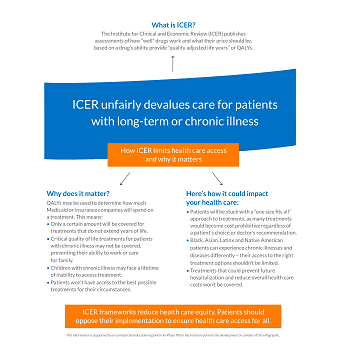ICER
How ICER assigns a lower life value to people with chronic illness.
Today, the data on long-term illness in the U.S. is startling:
-
-
- More than 1 in 4 U.S. adults live with a disability.1
- Nearly 2 million people annually are diagnosed with cancer.2
- The number of children with disabilities is on the rise.3
-
Long-term illness can take on many different forms for the people in our communities, like diabetes, hepatitis, lung cancer or difficult-to-see conditions like mental illness. Unfortunately, there’s one reality uniting many of these patients: The substantial cost of treatments and medications.
While cost of care is an issue that affects healthcare consumers, insurers and taxpayers alike, patients with chronic illness often rely on daily treatments to improve their quality of life. It’s critical that we protect care access and healthcare equity for these vulnerable populations, who rely on their treatments to work, care for family members and live life more fully. But new frameworks for medication cost control could devalue vulnerable patients’ care and leave them unable to access vital treatments.
ICER: Unfairly limiting care access
One of the main cost control frameworks under consideration comes from The Institute for Clinical and Economic Review (ICER). It’s an organization that publishes assessments of how “well” drugs work and what insurers should pay for them in a given year, based on a drug’s ability provide “quality adjusted life years” or QALYs.
Though well-intentioned, ICER frameworks will:
- Recommend that only a certain amount be covered for treatments that do not extend years of life – reducing coverage for many chronic illness therapies.
- Assign lower “life value” to patients with cancer and chronic illness, as ICER believes that most treatments will not return these patients to full health and insurers should pay less for their care.
- Implement a “one size fits all” approach to healthcare, as a patient’s ability to access care will be judged primarily on QALYs – not quality of life or a patient’s treatment goals.
- Take choices out of patients’ hands, as ICER would make many treatments cost prohibitive regardless of a doctor’s recommendation.
ICER frameworks reinforce unequal care access for children, people of color
- ICER’s focus on extending years of life would be extremely unfair to children with disabilities or chronic illness, who’s quality of life is essential to live, play and learn. They could face a lifetime of inability to access treatments.
- ICER also does not consider how different patients experience disease, according to a recent study4, including factors like how structural racism impacts care or how different racial and ethnic groups perceive symptom improvement.
If implemented, these changes will be directly at odds with healthcare equity goals.
There are better ways to control healthcare costs. Oppose ICER frameworks to ensure that everyone has access to the best possible treatments.
Download the Infographic!
1. https://www.cdc.gov/ncbddd/disabilityandhealth/infographic-disability-impacts-all.html
2. https://www.cancer.org/research/cancer-facts-statistics/all-cancer-facts-figures/cancer-facts-figures-2021.html
3. https://www.census.gov/library/stories/2021/03/united-states-childhood-disability-rate-up-in-2019-from-2008.html
4. https://www.crai.com/insights-events/publications/assessing-the-value-of-medicine-for-diverse-patients-implications-of-a-qaly-approach-for-health-disparities/

